English alumnus Andrew Street's curiosity of nature and palms paved the way for him to unearth several botanical discoveries
By Angelina Dobbs
Where most people see the ordinary, Andrew Street sees the extraordinary.
Since his days as an English-Creative Writing major at Florida State University, Street has led a life of discovery, traveling worldwide and pursuing an activity that is unlike what he learned in FSU classrooms: the collection and study of palms.
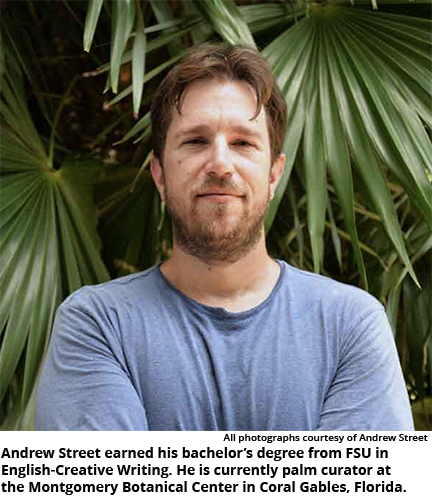 Today, Street is the sole palm curator at the Montgomery Botanical Center in Coral Gables, Florida. There, he takes care of the National collection of palm trees, consisting of over 6,000 specimens.
Today, Street is the sole palm curator at the Montgomery Botanical Center in Coral Gables, Florida. There, he takes care of the National collection of palm trees, consisting of over 6,000 specimens.
"I am happy to spread the knowledge, information, and love of palms," Street says, answering questions by telephone while sitting in a utility cart on the center’s property.
For Street, the outdoors is his office, and the sky is the ceiling.
His knowledge about palms and curious nature even turned one of his regular trips to Zoo Miami into a historic event. In February 2012, while walking through the zoo’s parking lot, Street saw a palm he had not noticed before. To the untrained eye, the palm might have looked no different from any other, but Street saw something special.
"When people go to the zoo and they see a palm, they say, ‘Oh, that's a palm,’” Street explains. “I can look at it a little bit more closely and see that it’s something distinct.”
Street brought the palm to the attention of Montgomery Botanical Center Executive Director M. Patrick Griffith, who agreed the palm was indeed unique. They launched a search to learn more about the mystery discovery.
Street visited numerous botanical gardens, asking if anyone recognized the palm. They reached out to their connections in the Caribbean because the palm had initially been collected from Cuba. They also put out notices for other palm specialists to be on the lookout for other specimens.
Street did not know at the time that he had discovered a palm species that was possibly extinct in the wild, a fact that an expert in Cuba suspected. Before Street’s unexpected find, it was only being grown in a few South Florida gardens.
The palm was known as ‘Cuban Short Petiole’, but did not have a species name. Street aptly named the species viridescens, Latin for "becoming green,” based on a physical characteristic.
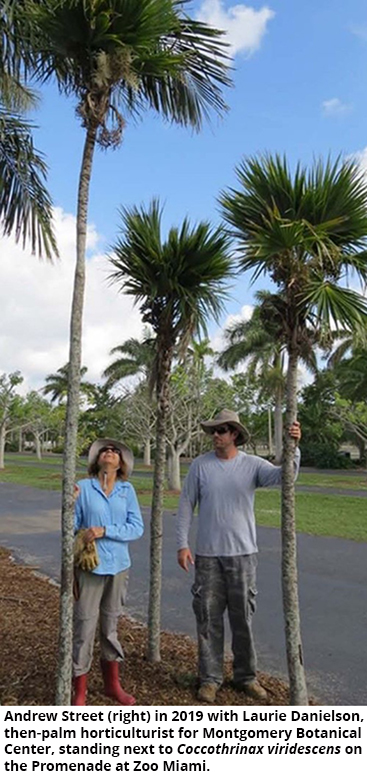 "On the backside of new leaves, it's silver, but on the older leaves, it's green, so the silver fades off, and it becomes green," he says.
"On the backside of new leaves, it's silver, but on the older leaves, it's green, so the silver fades off, and it becomes green," he says.
Street, Montgomery’s palm biologist Larry Noblick, and the center’s collections specialist Michelle Barros announced the discovery in a co-authored a paper, which was published in the July 29, 2019 issue of Phytotaxa, a journal devoted to botanical taxonomy.
As the palm curator, Street gets to travel all over the U.S. and the world, collecting specimens in Arizona, California, Texas, Hawaii, Colombia, and Bermuda. Street frequently documents his travels and studies in travel journals and International Palm Society newsletters and publishes his discoveries in scientific journals.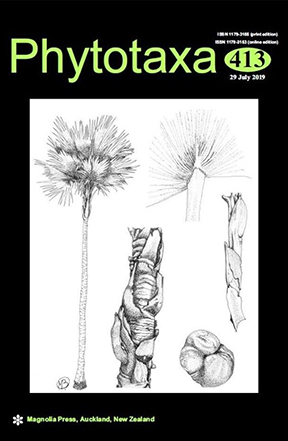
"My English degree in creative writing has really helped me out, especially with the number of books I had to read,” says Street, who graduated from FSU in 2006. “It helped with my vocabulary and lexicon, and my ability to put together sentences, understand people, and write efficiently and eloquently."
The Coccothinax viridescens is not Street's only palm discovery. He is engaged in a search for another palm collected from Puerto Rico that has not yet been scientifically discovered or named.
He also observed abnormal clustering behavior in Hemithrinax ekmaniana, one of the palms he grows with his father. Street detailed his findings in an article for the International Palm Society, which intrigued Celio Moya, an independent researcher specializing in the palm biology of Cuban and Caribbean palms.
"He thought it was fantastic because he'd studied that palm for 20 years, and he never knew they could do that," Street says.
Outside of palms, Street also rediscovered an extinct species of turtle. Similar to his experience at Zoo Miami, Street saw a turtle while visiting his sister and recognized its uniqueness. He argued the case to Anders Rodin, a retired orthopedic surgeon as well as a turtle researcher and conservationist, whom Street had never met. Still, he successfully convinced Rodin of his conclusion.
Street’s knowledge of turtles and capability to argue his case were byproducts of his studies on palms.
“The more I got into palms, the more I learned about turtles, and the more I felt like I had a fiduciary responsibility to look after them,” he says, adding that about 50 turtles now live in his backyard.
As an expert on palms and turtles, Street has been sworn in as a witness to testify on cases where his unique skill set is required to assess property damages and settle disputes. Street believes his proficiency in these areas has naturally extended into climate and geographical regions, which he credits learning about through travel.
I would say that education [in a classroom] is amazing in terms of learning, but the next best education is travel.
— Andrew Street
"I would say that education [in a classroom] is amazing in terms of learning, but the next best education is travel," Street says.
In many ways, Street's successful career after graduating from FSU mirrors that of someone with a doctorate degree in biology, not a bachelor’s degree in English. Yet, Street's encyclopedic knowledge of palms, turtles, and the climate did not come from a classroom.
Surprisingly, Street’s current academic interests began while purchasing his house in 2010. After making a deal with his wife to design the outside of the house, Street decided he wanted to take his renovations to the next level.
"I knew there was such a thing as high-end landscaping, and I didn't want to just go Home Depot," he says.
He visited plant nurseries for materials and information, and at one of the businesses, he found An Encyclopedia of Cultivated Palms. Cracking open the book marked a new chapter in Street's life. The photographs of the palms fascinated him, as did the notion that he could grow those trees in his own yard.
"It was cathartic. It was like an epiphany," Street says. "Right then and there, I knew what I wanted to do for the rest of my life."
Street joined the local South Florida Palm Society, became involved in the palm community, and started volunteering at Montgomery Botanical Center. In 2016, Jeffrey Block, curator of Block Botanical Gardens, asked Street to help him prepare and identify the Gardens’ palms for an upcoming tour by the International Palm Society.
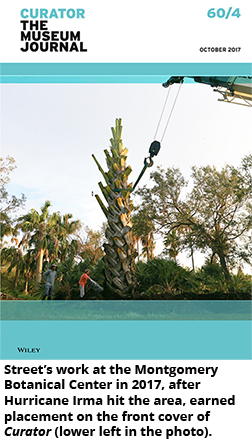
In a small-world moment, Street was working alongside Paul Craft and Scott Zona, two authors of An Encyclopedia of Cultivated Palms, 2nd Edition. Soon after that project, Street joined Zona on the International Palm Society’s board of directors.
"It’s crazy because I met all these authors who I thought were like rock stars," Street says.
Street demonstrated his own rock-star quality when Hurricane Irma hit the Montgomery Botanical Center in 2017, damaging and knocking over many of the rare plants cultivated there, including a Corypha taliera palm. That palm species is originally native to Myanmar and the Bengal region of India and Bangladesh.
"The reason why it's so important is that it's extinct in the wild," Street says. "We have in our collection here about 12 of them, representing more than half of that palm in the world."
The hurricane cut the power, leaving Street and his colleagues unable to irrigate the plants. To save the palm, Street explains, the staff covered the exposed roots with mesh and watered them by towing a 500-gallon tank behind a tractor.
They cut all the leaves off the palm to curb extra water loss and tracked the growth until the palm could be stood back up with a crane. The palm survived thanks to that quick thinking and was able to continue growing.
That ordeal earned Street a spot in October 2017 on the front page of Curator: The Museum Journal, the first time Street had been featured on a cover of a publication.
That is not the only stand-out honor he has earned, though.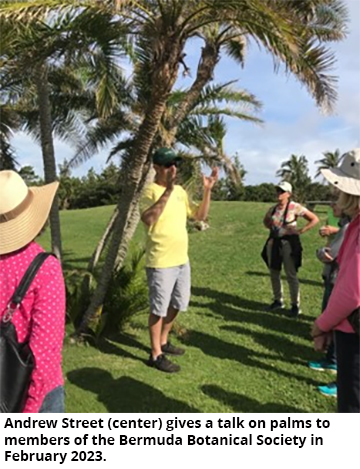
While Street was visiting Bermuda in 2023, he assessed palm collections at the Bermuda Botanical Society and other government parks and private gardens. Bermuda has strict laws to keep its native plants safe, and the workers for the society asked Street to help them better preserve the palms on various properties.
Street devoted many hours to checking that the palms were correctly identified, named, and maintained. He also led tours and gave talks to society members.
“When I left the country, Danny Simmons, who runs the botanical garden there, told me they created Bermuda Palm Awareness Week in my honor,” Street says.
Very few people with an English degree earn an Awareness Week in their honor, of course. But staying curious and keeping one’s eyes trained to look for peculiarities in their surroundings could lead to unexpected discoveries.
Through Street’s efforts, guided by the critical thinking skills he gained in FSU’s English department and inspired by his self-taught naturalism, he is supporting botanical communities around the world to thrive for generations to come.
Angelina Dobbs is a double major in English-Editing, Writing, and Media and in neuroscience.
Follow the English department on Instagram; on Facebook; and on X.

